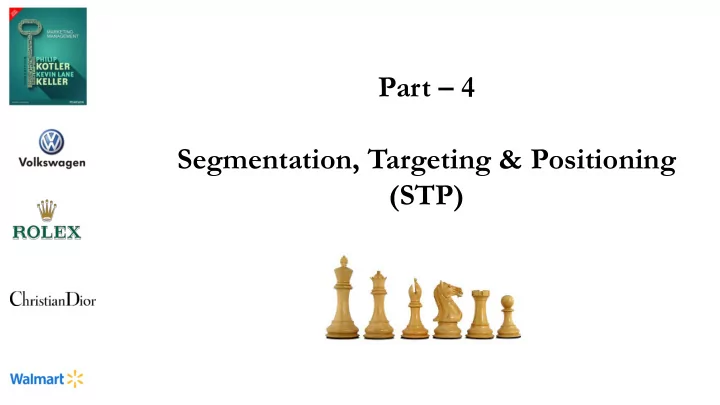

Part – 4 Segmentation, Targeting & Positioning (STP)
Resource Person MATHISHA HEWAVITHARANA MBA (Col),BBA Sp.Mktng (Col), PPG DIP. In Mktng (UK), MCIM (UK), Chartered Marketer (UK), Practicing Marketer (SL), ACMA, CGMA CIMA (UK), DBF (IBSL), AIB (IBSL), MSLIM(SL), Head of Branches - Siyapatha Finance PLC
Chapter Contents • Segmentation & Segmentation Variables • Targeting Strategy • Positioning Strategy
What is Segmentation ? A market segment consists of a group of customers who share a similar set of needs and wants. Segmentation is ….
Segmenting Consumer Markets Geographic Demographic Psychographic Behavioral
Segmentation variables in Consumer Markets o Geographic Segmentation Geographic segmentation divides the market into geographical units such as nations, states, regions, counties, cities, or neighbourhoods.
Segmentation variables in Consumer Markets o Demographic Segmentation Demographic segmentation divides the market based on a number of demographical factors.
Demographic Segmentation • Age and life cycle • Life stage • Gender • Income • Generation • Social class • Race and Culture
Segmentation variables in Consumer Markets o Psychographic Segmentation Psychographic segmentation divides the market based on psychological factors such as Personality, Lifestyle or Values & people with in the same demographic group can exhibit different psychographic profiles.
Segmentation variables in Consumer Markets o Behavioral Segmentation In behavioral segmentation, marketers divide buyers into groups on the basis of their knowledge of, attitude toward, use of, or response to a product.. Needs and Benefits Decision Roles – Initiator / Influencer / Decider / Buyer / User User and Usage – Occasions / user status / User rate / User readiness
o Behavioral Segmentation
Segmenting a Business Market • Demographic (Industry / Company size / Location) • Operating variable (Technology / Capacity) • Purchasing approaches (Purchasing Policies / Criteria) • Situational factors (Urgency / Size of order) • Personal characteristics (Risk Appetite / Loyalty)
Effective Segmentation Criteria • Measurable • Substantial • Accessible • Differentiable • Actionable
What is Targeting ? Targeting is the rational identification of segments to be focused in business.
Targeting Targeting includes following; Ranking the market segments according to the market potential Selecting the target segments accordingly
Targeting Targeting decision will be basically taken after considering the following two dimensions. Market attractiveness – profitability, market growth rate, entry costs, economies of scale, price competition etc. Business strength – relative market share, company image, learning curve effect, product quality, R&D, financial strength, patent rights etc.
Targeting Strategies Undifferentiated Targeting (One product to the Entire market) Concentrated Targeting (One product to One segment) Differentiated Targeting (Different products to Different segments)
What is Positioning ? Positioning is ……
Positioning process o Identifying Competitors o Analyzing Competitors o Defining POP & POD
Points of Difference (POD) “ Attributes or Benefits that Consumers Strongly Associated with a Brand by Believing that they Could not Find the Same in a Competitive Brand”
Points of Parities (POP) “ Attributes Which Are not Necessarily Unique to the Brand, But May In fact Similar to Other Brands”
Perceptual Maps / Positioning Maps “ Visual Representation of Consumer Perceptions and Preferences”
Positioning Approaches - Rational Approach / Informational Appeal (Functional Aspects of the Brand will be Highlighted – product performance / USP’s / benefits etc.) - Emotional Approach ( Emotional Selling Points – ESP’s)
Positioning Brand Mantra “ Three to Five word Articulation of the Heart & Soul of The Brand which goes par to Brand Essence or Core Brand Promise”
Re Re-positioning Re- positioning is ……
Review • Segmentation & Segmentation Variables • Targeting Strategy • Positioning Strategy
Thank You ! 0773 – 29 20 29 mathihewa@yahoo.com
Recommend
More recommend